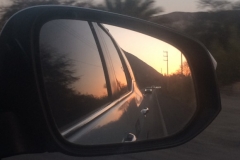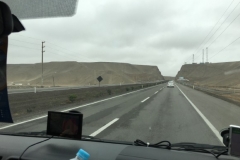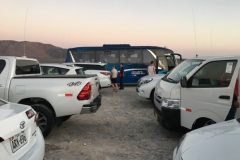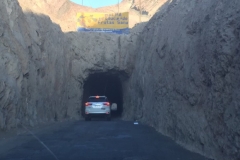Cars come and go as they please on the chaotic streets of Lima.
The Japanese crew looked out of the car windows apprehensively at the streets of Lima. They were riding with staff from Toyota Peru on a demonstration drive. Getting out of a car, Yamada from the Trial Production Division grumbled, “There are no rules... It’s no good. There’s definitely going to be accidents.” The team members’ faces had tensed up just hearing about the local traffic conditions and unwritten rules of the road even before driving training had started. They couldn’t help but feel worried about what lay ahead on their journey as they suddenly came upon broken traffic lights, saw three-wheeled taxis cut into traffic at the slightest opening and buses muscle their way forward, and heard the unending stream of car horns. Indeed, this environment is exactly what the team had been looking to experience. Adachi from the Performance Testing Division gritted his teeth on the day’s drive through the city, saying, “We have to stop thinking that countries like this exist and start thinking that there are a lot of countries like this.”
Required performance on streets filled with hazards.
The landscape quickly changed as we left the chaos of Lima and approached the Pan American highway and onward. The asphalt road cut a long ribbon through the dry land surrounded by dunes. It stretched for around 240 km to Nazca, famous for the geoglyph designs etched into its earth. Cars overtake each other all the time in Peru, and this highway is no exception.
If you’re behind a slow-moving truck, you readily want to pass it, but there’s only one lane in your direction, different from Japan where most highways are separated lane traffic. You have to gauge the distance with oncoming vehicles and accelerate quickly to overtake the truck. Many of the Japanese team members gripped the steering wheel and broke a sweat doing this. Owatari of the Drive Racing Systems Managing Division, said local team member Luis, who was driving a RAV4, also visibly exhaled as he overtook other vehicles.
“He was complaining that the car didn’t have enough power. He put the car into manual on purpose and downshifted before accelerating.” It seems that Owatari has learned some things about how cars are used in this land and what people expect from their cars.
Under poor road conditions like these, the team was forced to again pay attention to the importance of basic running, turning, and stopping performance. It’s the same with safety performance. Hayakawa, of the Vehicle Technology Development Division charged with the missions of repeating collision tests and pursuing safety, comments, “In Japan, you wouldn’t imagine a collision where both vehicles were going a hundred kilometers per hour, and some people might even think those tests are unnecessary. But as long as there are countries like this, we have job security.”
Ever-better cars in demand on the other side of the earth.
The drive team departed Nazca and immediately climbed up to highlands 4,500 m above sea level. Although suffering from altitude sickness, the team could not help but be amazed by the grandeur of the landscape. Occasionally they would spot animals like alpacas, vicugna, cows, and sheep amid the scenery. Hayakawa peppered Skyno from the local crew with questions—“Are those domesticated animals?” Passing a small hut perched on a cliff, “What about water and electricity?” “How do they get to town?” From his normal work you would think he would only be interested in local safety management conditions, but he most wanted to know how people lived their lives in this country. “Pursuing safety is of course important, but that can’t be all. If you spend all your budget on safety, some people will no longer be able to buy your cars, like the people here.”
After getting to Peru, Kanemori from the Performance Testing Division noticed that a lot of cars had broken headlights. “They must get broken from all the people who force their way into traffic. I’d like to recommend LED lights from a safety standpoint, but they’re expensive, so halogen bulbs might still be in higher demand.” Asked what he thought, Eduard from the local crew replied, “LED are nice and bright, but a little spendy.” Kanemori, who believes that the concept of ever-better cars differs from country to country, was satisfied at gaining this backing for his belief.
Driving the mountain passes in the Andes.
The conversation at driver change point rest stops while traversing up and down a series of mountain roads 3,000 m above sea level increasingly turned to the subject of power. The Yaris had no problem driving on city streets, but performed disappointingly on the mountain roads. Diesel engines demonstrated surprising power even at high elevations. The Prius possibly performed the best on winding roads. There was no end of things to talk about after getting over several mountains.
While driving on a mountain pass, Eduard of Toyota Peru asked what auto body colors were popular in Japan. Red is the most popular color in Peru, followed by black and silver. He said his wife drove a red Corolla. Asked why people choose the color red, he said red was easy to see in the streets and on mountain roads. It’s interesting that safety is a reason why people choose their car’s color. Drivers in Peru also honk their horn a lot. This too is for safety—as a form of communication signaling the car’s presence to others around them. The horn is also highly effectively on the winding mountain roads that the team is driving on each day. The Japanese crew is even now smartly sounding their horns while driving through the Andes.












